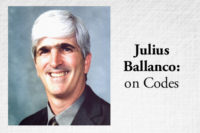If you did not submit a code change to the IAPMO Uniform Plumbing Code or Uniform Mechanical Code earlier this month, you are out of luck as far as changing the code until the 2021 editions.
Now, IAPMO begins its two-year cycle to develop the 2018 editions of the codes.
One of the major groups of changes being considered to the UPC and UMC are to the referenced standards. For many years the UMC and UPC just had a list of standards in what is now Chapter 17 of each code.
However, over the past few years, the policy has changed to referencing the appropriate standard in the body of the code. In other words, the standard is called out directly as to where it applies. Chapter 17 in the UPC and UMC merely identifies the full title and date of the standard.
While this change in process has been ongoing for the past few rounds, the 2018 cycle has proposed changes to complete the process of redefining how standards apply in the two codes. IAPMO created a task group to review all the standards of all the IAPMO codes – a monumental task. Just read a standard one day and then imagine reading all the standards. This is what this task group has done.
The concern with the table in Chapter 17 of the UPC and UMC is the inclusion of standards which are not referenced in the body of the code. Their presence appears to violate the intent of the policy for listing standards.
The task group has proposed to remove the standards not referenced in the body of the code from Table 1701.1. However, not all those standards will disappear completely from the code. What is proposed is a new table of standards that are a part of either the plumbing or mechanical profession. These standards will be listed separately and be available for the authority having jurisdiction to use when approving alternative materials or engineered designs.
Standards outside the scope of either the UPC or UMC are proposed for deletion from the code. These standards will not appear in the second table.
Test time
In the processes of reviewing all the standards in the codes, the task group realized some standards should be referenced in the code. For most of these standards, there simply has never been a code change to directly reference the standard. The task group prepared a number of changes to directly reference these standards.
A number of the standards being moved to the second table are IAPMO Guide Criteria. These are nonconsensus standards developed by IAPMO Research & Testing as a means of accepting new technology. It actually is an interesting process and very effective for gaining initial approval of a product.
When copper press connect fittings were introduced to the plumbing profession, IAPMO developed an IGC to regulate the fittings. This IGC was developed in less than three months. IAPMO then suggested taking the IGC and developing it into a consensus standard. It took 10 years for ASME to finally approve the consensus standard on copper-press fittings.
However, during that 10-year period the plumbing profession enjoyed the use of copper-press fittings since they had been approved through the IGC process.
Hence, IGCs are quick and effective, while consensus standards can take years. Imagine having to wait 10 years to sell a product you’ve developed.
Review session
The other assignment for the task group is to review the update of every standard. ANSI standards are required to be updated at least once every five years. When they are updated, the changes to the standards could impact the code. The task group reviewed the standards to determine if the changes are consistent with their reference in the code.
A good example of changes that occur to standards happened with the macerating toilet standard during the last code-change cycle. ASME A112.3.4 was referenced for macerating toilet systems. That standard was harmonized and expanded into ASME A112.3.4/CSA B45.9. Pumped-waste systems were added to the standard. As a result, the code language had to be revised to reference the installation of both macerating toilet systems and pumped-waste systems.
One of the grueling undertakings of the IAPMO Plumbing Technical Committee and Mechanical Technical Committee is the review of every standard being proposed to their code. I can attest it takes hours to go through every standard because I serve on the IAPMO Plumbing Technical Committee representing the American Society of Plumbing Engineers.
This cycle will be no different with many standards for the technical committees to review. The technical committees also are guided by the report from the standards task group.
I often am asked by plumbing and mechanical engineers why the codes go so crazy with referencing standards. Why is it important for the plumbing and mechanical engineering community?
The simple answer is the code becomes law when it is adopted by a state or local jurisdiction. That means any product specified by the engineer must meet the standards referenced in the code. Additionally, the use of the product must meet the limitations specified in the code.
Specifications for a project go hand-in-hand with the standards referenced in the code. The specification must identify the correct standard for the material to be code-complying. If the standard is not referenced in the code, the alternative or engineered design route must be followed to meet the code requirements.
All the proposed code changes to the UPC and UMC will be published in the next two months. You will be able to download the code-change books at www.iapmo.org. The two code-change books are only available electronically. IAPMO no longer prints the code-change books.
The first hearing of the code changes will take place from May 2-6 in Denver. The hearings are free to attend and anyone can testify on a code change.
I hope to see some of you in Denver.
This article was originally titled “The application of standards” in the January 2016 print edition of pme.



